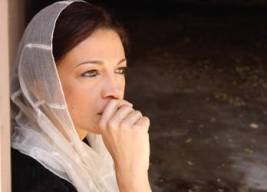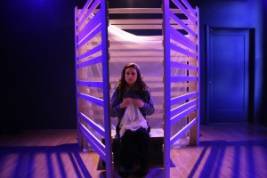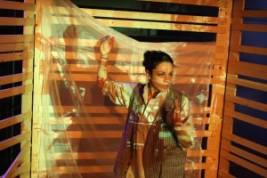
Say the name Benazir Bhutto to a cross-section of Pakistanis and you’ll probably get as many different points of view as those expressed by the characters who people Anna Khaja’s Shaheed: The Dream And Death Of Benazir Bhutto.
Khaja’s acclaimed one-woman show (she plays all eight of its characters) has now returned for several Hollywood Fringe Festival performances before heading off to the New York International Fringe Festival in August.
A bit of historical background: As Prime Minister of Pakistan, Benazir Bhutto (1953-2007) was the first woman elected to lead a Muslim state. A graduate of Harvard and Oxford universities, Bhutto endured the execution of her former Prime Minister father and her own imprisonment under solitary confinement before being twice elected P.M. (in 1988 and 1993) and twice removed from office under charges of corruption. Following a period of self-imposed exile, Bhutto returned to Pakistan in October of 2007. Less than three months later she was dead, the victim of an assassin’s bullet.
Khaja opens Shaheed as Sara, an American co-ed for whom Pakistan’s fragmented life (it began as East and West Pakistan, two halves of the same country separated by a distance of over one thousand miles) reflects Sara’s own fragmented identity as the daughter of a Pakistani father who disappeared when she was little following “some kind of bullshit religious epiphany” and an American mother who refused to talk about him. The events of 9/11 inspire Sara to delve into Pakistani history and culture, most particularly into the life of Benazir, a woman whom Shaheed lets us see through the eyes of five different Pakistanis—and Condoleezza Rice—before introducing us to the lady herself. Each of Shaheed’s eight scenes takes place on December 27, 2007, the date of Benazir Bhutto’s assassination.
Khaja brings all of Shaheed’s female and male characters to life in eight strikingly different performances.
Following Sara, there is Condoleezza, who claims to see herself in Benazir (“We are the same age, women of color, politicians, forgers of democracy”) yet then goes on to threaten freezing all her monetary assets should she not do as the United States expects.
International journalist Daphne Barak is Benazir’s best friend who warns her to “get the fuck out” of Pakistan—and promotes her website www.DaphneBarak.com. Pakistani religious studies professor Cuseem, who like Benazir suffered the horrors of solitary confinement and torture, explains to his Boston University students the various meanings of the much misused word “jihad” and reflects on his life in exile. Benazir’s embittered niece Fatimah blames her aunt for “those willing to die for Benazir,” declaring angrily that “there is blood on your hands, Auntie. So much blood. And for what?” Shamsher, a poor rehri driver, expresses the hope that Benazir’s return to Pakistan will mean that he can earn enough money to bring his 13-year-old daughter Afshan home from the madrasa where her food, clothing, and religious education are free, but where family visits are forbidden.
Shaheed’s most horrific sequence introduces us to Afshan herself, a teenager still more child than woman, who gleefully describes how she and her classmates pulled a prostitute from her bed, “charged her, and dragged her to the corner and beat her until she bled from the ears.” Horrendous as this act it, it pales in comparison with what Afshan then goes on to reveal.
Finally, there is Benazir herself, who speaks to us in the minutes before stepping out into the crowd which took her life.
As an acting vehicle, Shaheed provides its writer/star with yet another opportunity to show what Anna Khaja fans already know—that this is one of L.A.’s finest, most powerful, and most versatile actors. With this stunning piece of theater, she proves herself an equally fine writer, one whose words are sure to provoke much discussion (and much online research into the life of Benazir Bhutto).
Credit for Shaheed’s success is shared by director Heather de Michele, who keeps the play visually varied, aided by Carrie LaFerle’s dramatic lighting design and Sharif Khan’s equally fine sound design, which makes us hear as well as see the Pakistani world Shaheed introduces us to. Maureen Weiss’s set design slowly transforms itself from a wood-slatted wall into a cage-like enclosure, the closer we get to Benazir herself. Sam Saldivar’s projection design and Colyn Emery and Phil Young’s original music add to Shaheed’s moody, exotic atmosphere. Luis Reyes is producer, LaFerle and Victoria Watson stage managers, Vincent Richards assistant set designer, and Anna Fitzwater costume consultant.
Shaheed is that rare theatrical work that engrosses, elucidates, provokes discussion—and provides its star with a tour-de-force showcase for her gifts. On all these levels and more, it is a resounding success.
Open Fist Theatre, 6209 Santa Monica Blvd., Los Angeles.
www.shaheedtheplay.com
–Steven Stanley
June 22, 2010
Photos: Maia Rosenfeld





 Since 2007, Steven Stanley's StageSceneLA.com has spotlighted the best in Southern California theater via reviews, interviews, and its annual StageSceneLA Scenies.
Since 2007, Steven Stanley's StageSceneLA.com has spotlighted the best in Southern California theater via reviews, interviews, and its annual StageSceneLA Scenies.







 COPYRIGHT 2024 STEVEN STANLEY :: DESIGN BY
COPYRIGHT 2024 STEVEN STANLEY :: DESIGN BY